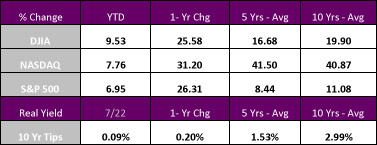Filed under: Economic Recovery, Housing Market Trends, Norhill Wealth Strategies Report, Retirement Investing, Senior Investing, Slow recovery | Tags: economic indicators, Economic Outlook, home sales, housing market, markets updates, Norhill Wealth Strategies Report, Warren Elkin
Mixed news for housing market
The scorching heat wave that set record temperatures across much of the nation didn’t extend to the economy, which remains tepid at best according to the latest readings. There was a rise in the Conference Board’s index of leading economic indicators and a bump in new residential construction. However, existing-home sales dropped for the third straight month as President Barack Obama and congressional leaders continued to negotiate over an increase in the nation’s debt limit.
Leading indicators advance
The index of leading economic indicators rose 0.3% in June, less than May’s 0.8% jump but still an encouraging sign that April’s -0.3% reading represented temporary factors and was not part of a larger trend. Compared to June 2010, the index was about 6% higher. Five indicators rose in June, with real money supply the largest contributor, followed by interest rate spread. Stock prices were the largest detractor, along with consumer expectations. The coincident index, which measures current economic activity, inched ahead 0.1%. The indexes are a compilation of indicators that can provide insight into both current and future activity in the broader economy.
Tumble continues for existing home sales
Sales of existing homes fell 0.8% in June to an annualized rate of 4.77 million. The monthly decline-the third straight-was unexpected but attributed to a rise in canceled contracts and the tough economy. Sales were down 8.8% compared to June 2010, when the first-time home buyer tax credit was still in effect. Most of the decline was the result of condominium sales, which dropped 7%. Single-family home sales were unchanged. Across the regions, sales rose slightly in the Midwest, were stable in the South, and fell in the Northeast and West. Compared to a year ago, the median existing-home price was up 0.8%, to $184,300.
The economic week ahead
Next week’s slate of economic news is a bit heavier. Reports on consumer confidence and new-home sales are scheduled for Tuesday, followed by durable goods and the Federal Reserve’s Beige Book nationwide survey of economic activity on Wednesday, and employment costs and real gross domestic product on Friday.
Markets Update
Warren Elkin of Norhill Financial is your safe money strategist. When it comes to your hard earned dollars, he can keep your money secure as it grows. Warren Elkin can be reached toll free at 877-476-5051- or by email at elkininc@aol.com. To learn more about him check out www.warrenelkin.com.
Filed under: Consumer Spending, Economic Outlook, Norhill Wealth Strategies Report, Protect your money, Retirement Investing, Senior Investing
The Debt Ceiling Crisis
Egan Jones, a small debt rating company, is about to announce early this week of a sovereign debt rating decrease. This is only remarkable since this company is usually far ahead of both Moody’s and S&P. They are also funded by investor groups instead of the companies they rate, unlike other major bond rating companies.
The President and Congress are far apart in their negotiations with only two weeks until the August 2 deadline. The President has offered three dollars of cuts for every dollar of tax increase. The Congressional Republican negotiators are asking for cuts in spending with no tax increase at all. On Tuesday Congress will vote on the “Cut, Cap and Balance” proposal. This will make $2 trillion of cuts with no debt ceiling increase. But the controversial apart is the proposal of the Balanced Budget Amendment. This is unlikely to pass since it requires two thirds of the states to ratify and 60 senators. Moody’s and S&P have indicated they will downgrade the US debt rating if the US debt ceiling is not increased with a commensurate plan to decrease future debt.
If the US debt is downgraded from AAA, it will create more expensive mortgages as well as more expensive consumer loans are linked to the 10 year Treasury Bond. The current ratio of US GDP to the debt is 106%. While the size of the US government is continually increasing, 72% of Americans favor a free market economy over one manage by the US government (according to a recent Rasmussen survey).
Retirees Are Scared
According to the Employee Benefit Research Institute, a survey of 1260 retirees showed that half of the respondents said they are either “not at all confident” or “not to confident” about their savings and income sources to fund a decent retirement. This is the highest level of pre-retiree uncertainty in the 21 year history of the survey.
Where the World’s Millionaires Live
While there are approximately 12.5 million households with a net worth of $1 million plus, the US came in first with 5.2 million. Japan was second with 1.5 million while China trailed with 1.1 million. But in terms of where millionaires most like to live, 15.5% of Singapore’s population were millionaires followed by Switzerland at 9.9%, Qatar is at 9% and Hong Kong at 8.7%. So if you think it’s expensive where you live, try moving to the high rent district of these countries.
How to Protect Your Money
As the economy continues to struggle investors are not only looking for ways to protect their money but also how to get a better return on their investments. Why Interest rates are not going up anytime soon and what you can do about it. David Gibson of Gibson Financial in Pontiac has some thoughts. Because of the weak economy the Fed is reluctant to raise the prime interest rate which translates to low rates of return for your money in the bank. David Gibson recommends financial products such as fixed rate annuities. They protect principal and can give a rate of return at about an average of 6% in many cases. David also commented on the Dodd- Franks Law, which limits speculation for the average citizen. According to David, this will not affect your ability to buy actual gold or precious metals, but will make it so you can not trade on the futures markets or ‘paper’ commodities unless you have $1 million in assets or an income of $250,000+. It’s designed so the average person doesn’t get clobbered and not have the cash to cover any losses. Rest assured, you can still buy the real thing when it comes to metals and commodities.
Warren Elkin of Norhill Financial is your safe money strategist. When it comes to your hard earned dollars, he can keep your money secure as it grows. Warren Elkin can be reached toll free at 877-476-5051- or by email at elkininc@aol.com. To learn more about him check out www.warrenelkin.com.
Filed under: Consumer confidence, Inflation, Retirement Investing, Senior Citizen Careful Money, Senior Investing, Slow recovery | Tags: financial security, Income after retirement, Inflation, Norhill Wealth Strategies, Preparing for retirement, setting retirement goals, Warren Elkin
Planning for The “Golden Years”
There’s a saying that if you have your health, you have everything. Well, that’s not exactly true – without adequate resources, you could enjoy a long, healthy retirement at a far lower standard of living than you’d prefer!
When preparing for retirement, it’s vital to keep in mind the importance of money to your quality of life during your “golden years.” And with retirements now stretching as long as 20 to 30 years – and beyond – ensuring your retirement dollars outlive you is a paramount concern.
Failing to Plan, or Planning to Fail?
It’s been said that he who fails to plan, plans to fail. And nowhere is that concept illustrated more starkly than with retirement planning. A sound financial plan can be the difference between the retirement of your dreams and the nightmare of discovering you have too little money, too late to change financial course.
A disciplined retirement preparation plan, diligently followed, will help you develop realistic objectives … assess progress toward your goals … and make periodic adjustments to keep you on track.
How Much Retirement Income Will YOU Need?
Government research has determined that most Americans need between 60 and 80 percent of their pre-retirement income in order to maintain their standard of living during retirement. However, many financial experts have raised this figure to between 80 and 100 percent of pre-retirement income, citing skyrocketing healthcare costs, lengthening life spans, and the ever-present threat of inflation – which can rob a retirement portfolio of purchasing power over time.
Of course, how much you will need in retirement will be a function of your goals, time horizon, and spending habits. Those who want to purchase a second home and travel frequently will obviously need more than those who prefer to stay at home in their paid-off house. Consider these factors when estimating your future retirement income needs:
- Your support of children who will be self-sufficient by the time you retire
- Your current work-related expenses that will be dramatically reduced in retirement, such as commuting costs, daily meal expenses, dry cleaning bills, etc.
- Whether your mortgage will be paid off prior to or early in retirement
- Whether you will need to continue your monthly savings amount or begin to spend that amount for necessities
- Your tax bill in retirement
Sources of Retirement Income
Once you have estimated your target retirement income, you can begin evaluating your potential sources of regular income. In general, your income sources will fall into one of these three categories:
1) Government sources. The Social Security system was inaugurated during the Great Depression to augment retirees’ incomes. Most experts feel that the system will remain solvent throughout much of the 21st century. Even so, a rising retirement age and cuts in benefits could reduce your monthly Social Security check. Benefits are based on the amount you earned during your working years.
2) Employer-sponsored plans. Many employers offer company-sponsored retirement plans, which generally fall into two categories. Defined benefit plans, which are normally funded by the employer and guarantee a retirement benefit based on a formula comprising number of years on the job and employment earnings. For example, a traditional pension is a defined benefit plan. Defined contribution plans, on the other hand – such as 401(k), 403(b), and 457 – rely on funding from employees, matching funds from the employer, or a combination of the two. The employee owns an account balance (subject to company rules regarding vesting) of contributions and earnings. Upon changing jobs, an employee may be able to roll over assets into the new employer’s plan or into an IRA. At retirement, the employee decides how to withdraw the balance he or she has accumulated.
3) Personal savings. This is perhaps the most overlooked aspect of retirement planning. Personal savings include, but aren’t limited to, balances in savings accounts, directly held assets, home equity, shares in a partnership or business, and even collectibles such as artwork and coins.
How to Get – And Stay – On Course
How can you determine whether you’re on track to reach your retirement goals, and to make adjustments if necessary? We can help you develop a sound financial plan based on your specific situation, monitor it regularly to ensure you’re making progress toward your objectives, and recommend occasional adjustments to help you stay on course.
Material discussed is meant for general illustration and/or informational purposes only and it is not to be construed as tax, legal, or investment advice. Although the information has been gathered from sources believed to be reliable, please note that individual situations can vary therefore, the information should be relied upon when coordinated with individual professional advice. Past performance is no guarantee of future results. Diversification does not ensure against loss.
The Real Story Behind Inflation
If the same methodology that was used in 1980 to chronicle the double digit inflation of that era were in use today, we would have an inflation rate of ten percent right now, according to Shadow Government Statistics (http://www.shadowstats.com). ; We are entering a massive era of stagflation which recalls to us our writing in Catastrophe, published two years ago, that “inflation may well be the enduring legacy of the Obama presidency.”
How does the federal government understate the inflation rate?
1. It excludes food and fuel costs from its rate of “core inflation.” Each month, the Federal Reserve calms national inflation fears by pointing to the low rate of core inflation, currently at an annual pace of just 2.1%. It reaffirms that the economy is meeting the goal set for it by the Fed of keeping core inflation around or below two percent.
Claiming that food and fuel are too unstable to be included in the inflation rate, it excludes precisely those areas in which inflation is felt most deeply. In the past year, the cost of commodities from corn to soybeans has doubled and the price of gasoline at the pump is one third higher than it was one year ago. The average American household budget devotes one-third of its cash to food and energy costs. Leaving these elements out of the inflation rate has no justification.
2. It substitutes less expensive products when prices rise. When prices go up, the economists who generate the Consumer Price Index substitute less a expensive alternative product for the one that has risen in price. For example, if the cost of steak goes up, the CPI does not reflect the increase, but simply replaces steak with hamburger in computing the price index.
3. It excludes “hedonistic” products as price rises. The Fed adjusts for price rises by dumbing down the luxury elements of the products whose price it measures. It might, for example, measure the price of cars without air conditioning as a way of avoiding reporting the increase in the cost of automobiles. Even when the luxury features cannot easily be removed from the product, the CPI economists assume that they are.
4. In averaging the price of different commodities, it uses a geometric — not an arithmetic mean. Since the geometric mean, which compares the square roots of product prices, comes out lower, it understates the rate of inflation. See the table below comparing two products’ prices a year apart:
Commodity Start Price Final Price Expenditure Increase
A $1.00 $1.00 $0.00
B $1.00 $1.50 $0.50
Total Expenditure $2.00 $2.50 $0.50
To the layman, an increase in total spending of 50 cents on a base of $2 would represent a 25% increase in price. But that uses the arithmetic mean.
The geometric mean compares the square root of (new price / original price) multiplied by the same for the other commodity. Using this method of calculation, the increase in price would only be 22.5%.
The CPI switched to geometric comparison in 1994. But no matter how the federal economists bend and twist the data, most Americans realize that we are in for a massive bout of inflation.
And this inflation is dramatically different from the last hyper inflation of the late 70s and early 80s. That inflation was caused by too much money chasing too few products. To slow down the economy and tame price increases, the Fed raised interest rates. But this inflation has nothing to do with demand. Rather, it is caused by the upward push of costs like gasoline, taxes, food, health insurance, and, soon, interest rates. This cost-push increase in prices cannot be tamed by cooling off the economy, which is, in fact, so cool already that it is approaching zero growth.
Warren Elkin of Norhill Financial is your safe money strategist. When it comes to your hard earned dollars, he can keep your money secure as it grows. Warren Elkin can be reached toll free at 877-476-5051- or by email at elkininc@aol.com. To learn more about him check out www.warrenelkin.com.
Filed under: Consumer confidence, Economic Outlook, Economic Recovery, Gross Domestic Product, Inflation, Norhill Wealth Strategies Report, Retirement Investing | Tags: credit demand, Economic crosswinds, economic week ahead, Inflation, Market Updates, Norhill Wealth Strategies Report, service sector slows, Warren Elkin
Warren Elkin of Norhill Financial is your safe money strategist. When it comes to your hard earned dollars, he can keep your money secure as it grows. Warren Elkin can be reached toll free at 877-476-5051- or by email at elkininc@aol.com. To learn more about him check out www.warrenelkin.com.
Filed under: America’s Safe Money Expert, No Risk Investments, Retirement Investing, Safe Investments, Safe Money, Senior Citizen Careful Money, Senior Investing, Warren Elkin, Warrenelkin.com, Zero Risk Investments | Tags: America’s Safe Money Expert, No Risk Investments, Retirement Investing, Safe Investments, Safe Money, Senior Citizen Careful Money, Senior Investing, Warren Elkin, Warrenelkin.com, Zero Risk Investments
By Warren Elkin, www.warrenelkin.com
If you have lost or quit your job you will need to make plans to deal with your 401k plan. Too often people are so overwhelmed by their circumstances to understand the full ramifications of simply withdrawing the money. If you withdraw the money you are automatically charged a 25% penalty on the total savings, plus there are additional tax ramifications. Why decimate your retirement fund if you don’t have to?
A smarter choice is to simply roll the monies over to another account, whether it is your new employers 401k, a roll over IRA or an annuity. Putting the money in an IRA offers you the most flexibility in terms of withdrawals and distributions. Annuities offer upfront bonuses and a guarantee of retirement income no matter how long you live. Either way you will want to consult with a financial expert who can differentiate between the different roll over plans and what you require daily.
Should you have any questions, or want to talk to me directly, please call me at your convenience at 877-476-5051 for a complimentary consultation or email me at warren@warrenelkin.com. You can also find more helpful information on my site at www.warrenelkin.com.
Filed under: America’s Safe Money Expert, No Risk Investments, Retirement Investing, Safe Investments, Safe Money, Senior Citizen Careful Money, Senior Investing, Warren Elkin, Warrenelkin.com, Zero Risk Investments | Tags: America’s Safe Money Expert, No Risk Investments, Retirement Investing, Safe Investments, Safe Money, Senior Citizen Careful Money, Senior Investing, Warren Elkin, Warrenelkin.com, Zero Risk Investments
By Warren Elkin, www.warrenelkin.com
Reverse mortgages are widely advertised, but when it comes time to research them, there is surprisingly little information about their impact on your financial future.
Reverse mortgages are meant to be a solution for Seniors who have faithfully built equity in their home and now find themselves without enough income to retire. A reverse mortgage allows you borrow against the equity in your home without having to make a monthly payment and without having to move.
There are several things to consider however.
Reverse Mortgages can be expensive. The generally have large closing costs and are always more cost effective over longer periods of time. If you are only planning on staying in your home for a short period of time you might want to consider other options.
There are possible tax implications from getting a reverse mortgage that can affect your eligibility for government assistance and your estate after your death. Make sure you know the facts before signing any mortgage papers.
Government insured Home Equity Conversion Mortgages (HECM) tend to be less expensive than private sector reverse mortgages. Talk to your financial advisor about the differences.
For more information on Reverse Mortgages, contact Warren Elkin America’s Safe Money Expert.
Should you have any questions, or want to talk to me directly, please call me at your convenience at 877-476-5051 for a complimentary consultation or email me at warren@warrenelkin.com. You can also find more helpful information on my site at www.warrenelkin.com.
Filed under: America’s Safe Money Expert, Retirement Investing, Safe Investments, Safe Money, Senior Citizen Careful Money, Senior Investing, Warren Elkin, Warrenelkin.com, Zero Risk Investments | Tags: America’s Safe Money Expert, No Risk Investments, Retirement Investing, Safe Investments, Safe Money, Senior Citizen Careful Money, Senior Investing, Warren Elkin, Warrenelkin.com, Zero Risk Investments
By Warren Elkin, www.warrenelkin.com
If you’ve been to a financial advisor in the past decade you probably at some time were encouraged to invest in mutual funds. You were probably told that mutual funds are a great safe investment that offers diversification. Then you were probably shown specific funds and shown a brochure that included a bio, sometimes even a picture of the fund manager, who on the brochure looks like the soul of responsibility.
Here’s what you typically don’t hear when you are being offered mutual funds.
Fund Managers are paid bonuses based on the performance of the fund. The shorter the timeline on their bonus, the more likely that your fund manager will take risks with your funds, in order to receive his bonus.
Mutual funds have hidden fees that are not included in their expense ratio. The more often a fund turns over, the higher the costs to the stock holder.
And, as for diversity, buying Mutual Funds does not guarantee diversity. In fact, because funds tend to gravitate to well performing stocks, you may find that a high percentage of your “diversified” mutual funds are actually invested in the same stocks as your 401K and other retirement investment.
Mutual funds have the potential to be a sound investment for some individuals but it is important to know all of the facts and to compare them to other investment strategies to determine what is right for you.
For more information about mutual funds or other investment strategies, contact Warren Elkin, America’s Safe Money Expert.
Should you have any questions, or want to talk to me directly, please call me at your convenience at 877-476-5051 for a complimentary consultation or email me at warren@warrenelkin.com. You can also find more helpful information on my site at www.warrenelkin.com.
Filed under: America’s Safe Money Expert, No Risk Investments, Retirement Investing, Safe Investments, Safe Money, Senior Citizen Careful Money, Senior Investing, Warren Elkin, Warrenelkin.com, Zero Risk Investments | Tags: America’s Safe Money Expert, No Risk Investments, Retirement Investing, Safe Investments, Safe Money, Senior Citizen Careful Money, Senior Investing, Warren Elkin, Warrenelkin.com, Zero Risk Investments
By Warren Elkin, www.warrenelkin.com
Twenty five years ago individual retirement accounts were the “new kid” on the retirement investment block. A quarter of a century later, most Americans are familiar with IRAs but would be hard pressed to tell you how the three different varieties can work for them to create a retirement nest egg.
The three main types of IRAs are Traditional IRA, Roth IRA and Simplified Employee Pension (SEP). Each one serves a different purpose and has its individual benefits.
Traditional IRAs are tax deductable in the year contributions are made. While this can mean a smaller tax bill, it also means that the funds will be taxed upon distribution.
Roth IRAs on the other hand offer no tax deduction in the year in which they are contributed, but there is no taxation upon distribution. This allows you to grow retirement funds tax free. However Roth IRAs have income restrictions. If you make more than $95,000 (AGI) as an individual or $150,000(AGI) as a couple, you are not eligible for a Roth IRA. Both Roth and Traditional IRAs have contribution caps yearly.
SEP Retirement Accounts are designed for the self-employed and small business owners. A SEP account allows you to contribute up to 25% of your yearly income (up to $46,000 for 2009). There are other restrictions on SEP accounts based on other criteria.
For more information on IRA accounts contact Warren Elkin, America’s Safe Money Expert.
Should you have any questions, or want to talk to me directly, please call me at your convenience at 877-476-5051 for a complimentary consultation or email me at warren@warrenelkin.com. You can also find more helpful information on my site at www.warrenelkin.com.
Filed under: America’s Safe Money Expert, No Risk Investments, Retirement Investing, Safe Investments, Safe Money, Senior Citizen Careful Money, Senior Investing, Warren Elkin, Warrenelkin.com, Zero Risk Investments | Tags: America’s Safe Money Expert, No Risk Investments, Retirement Investing, Safe Investments, Senior Citizen Careful Money, Senior Investing, Warren Elkin, Warrenelkin.com, Zero Risk Investments
By Warren Elkin, www.warrenelkin.com
The current market holds many pitfalls for the soon to be retiring. There are many equations floating around about what percentage of your income you will need in order to retire on time and not outlive your money. Unfortunately these equations are not always accurate and they frequently assume that you won’t be needing a great deal of health care of dental care past the age of 65. I doubt that you have worked hard your entire adult life to discover at the age of 70 that you can’t afford a simple trip to the dentist and yet it happens to some seniors. One thing you can do to protect yourself from devastating medical bills is to acquire supplemental health insurance now.
Another important consideration in your retirement plans should be inflation. What it costs to live to today will more than likely not be the same as what it costs to live in fifteen years. If you are on fixed income, how will you account for inflation?
One of the scariest consequences of faulty retirement planning is the notion of outliving your money. Are you betting that you will only live fifteen years into your retirement? What happens if live longer? Is there a possibility that you will outlive your retirement funds? This is a nightmare looming over many senior citizens heads. Remarkably, it doesn’t have to be a concern. There are easy solutions to these problems that offer guaranteed interest rates and the assurance that you won’t outlive your money.
For more information on these and other types of safe investments contact Warren Elkin, America’s Safe Money Expert.
Should you have any questions, or want to talk to me directly, please call me at your convenience at 877-476-5051 for a complimentary consultation or email me at warren@warrenelkin.com. You can also find more helpful information on my site at www.warrenelkin.com.
Filed under: America’s Safe Money Expert, No Risk Investments, Retirement Investing, Safe Investments, Safe Money, Senior Citizen Careful Money, Senior Investing, Warren Elkin, Warrenelkin.com, Zero Risk Investments | Tags: America’s Safe Money Expert, No Risk Investments, Retirement Investing, Safe Investments, Safe Money, Senior Citizen Careful Money, Senior Investing, Warren Elkin, Warrenelkin.com, Zero Risk Investments
Warren Elkin/ www.warrenelkin.com
Does your retirement fund need protection? It’s worth it to take a look at your current retirement portfolio and determine what steps need to be taken to protect your investments against further losses. There are many different choices you can make based on your current retirement savings status. The smartest thing to do is consult with a financial expert who understands the unique challenges facing investors about to retire.
One expensive but effectual way to prevent future losses is buying insurance on a portion of your portfolio called a put option. For a fee you can determine the margin beyond which you would like to be insured. If the stock were to go lower than that predetermined number and you were to sell it you would be guaranteed what ever amount you had insured for. This insurance can be cost prohibitive so buyer beware.
Currently one of the easiest and most secure ways to protect your retirement funds is to buy into a government regulated, interest guaranteed annuity. These funds provide peace of mind as they have a provision that ensures that you can’t outlive your money. The guarantee ensures that you are making money even in a weak market, but allows you to benefit in strong market as well. Isn’t that the kind of guarantee you want for your retirement funds?
Grow your retirement fund while protecting your investment, call Warren Elkin, America’s Safe Money Expert.
Should you have any questions, or want to talk to me directly, please call me at your convenience at 877-476-5051 for a complimentary consultation or email me at warren@warrenelkin.com. You can also find more helpful information on my site at www.warrenelkin.com.





